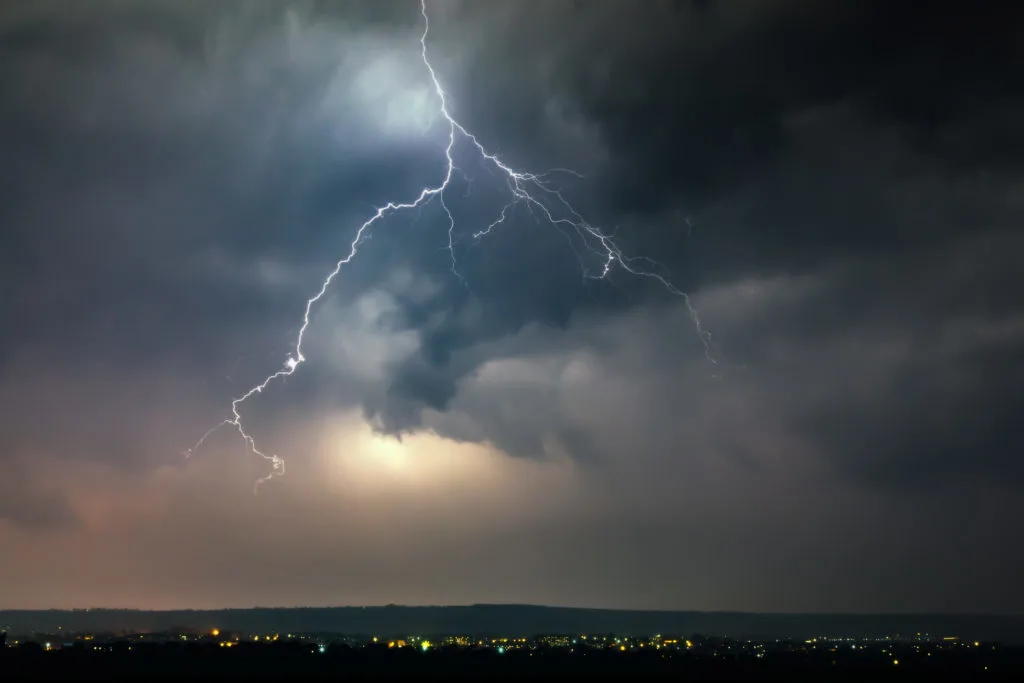
Many German Shepherd owners have experienced this – that moment when your protective and fearless dog suddenly acts as though his world is ending, all because of a change in the weather.
All jokes aside, the fact is that this happens – a lot. When a thunderstorm is on its way, oftentimes our GSDs begin to experience extreme amounts of stress, fear, and anxiety. But why is this – why are some German Shepherds afraid of thunder?
Some dogs are afraid of thunder not only because of its loud sound, but because thunderstorms are accompanied by changes in temperature, drops in atmospheric pressure, and increased static electricity. Dogs are acutely sensitive to these changes, and they often react to them through confusion, fear, and anxiety.
All of these things can combine to make your GSD truly frightened during a thunderstorm. It’s important to understand how detrimental this can be for your dog, as even the calmest of dogs can become quite unpredictable when he is fearful of something.
His fear may cause him to bolt, which can lead to him being injured or getting lost.
In this article, we will look at why some dogs are frightened of thunderstorms, as well as some useful solutions to manage or eliminate your German Shepherd’s fear of thunder once and for all.
Click Here to Jump to a Section
What Causes a Fear of Thunder?
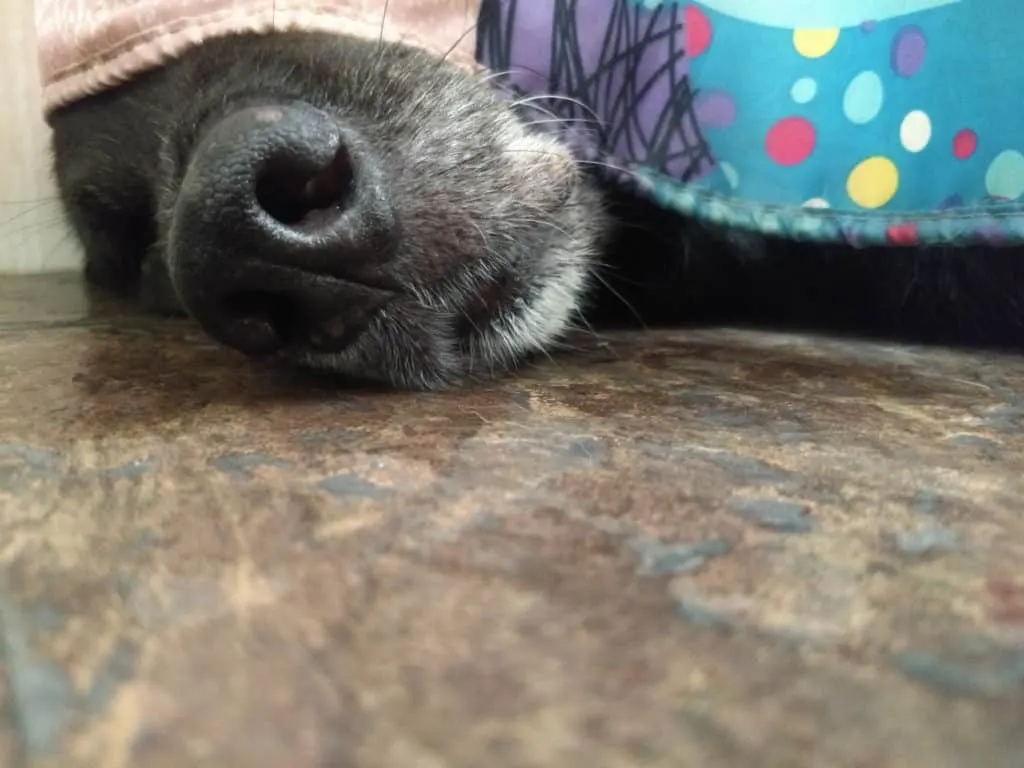
There isn’t just one cause behind any dog’s fear of thunder. Causes range from the storm itself to how a dog was raised. It’s also important to consider any prior traumatic events that a dog may have experienced early on in life.
It should also be noted that, according to a survey conducted by the School of Veterinary Medicine at Tufts University about thunderstorm phobia in dogs, herding breeds like German Shepherds are more likely than other breeds to have a fear of thunder.
It helps to understand the particular elements that cause a dog’s fear of thunderstorms, so let’s now break down the elements of a storm and the various reasons why your German Shepherd may react anxiously to one.
Noise, Vibration, Pressure Drops and Static Electricity
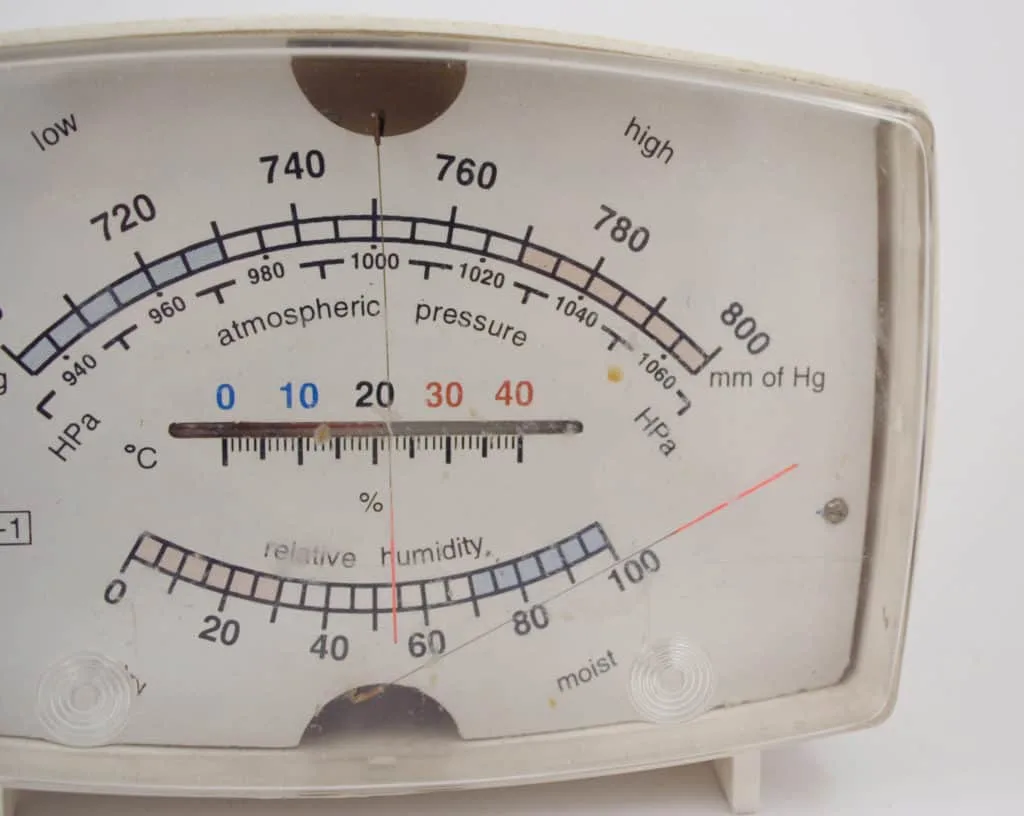
While thunder is simply a loud sound, it is most often accompanied by a number of other weather conditions.
Thunderstorms are usually accompanied by high winds and bright flashes of lightning. In addition, the sound of thunder is literally earth-shaking.
These things, accompanied by a change in temperature and a drop in barometric pressure are unfamiliar and can be overwhelming to a German Shepherd.
It has also been theorized by Dr. Nicholas Dodman, the director of the Animal Behavior department at the Cummings School of Veterinary Medicine at Tufts University, that the static electricity which is present during thunderstorms actually causes dogs to experience electrical shocks through their fur.
If we take this theory and apply it to a German Shepherd’s behavior during a thunderstorm, it makes a lot of sense.
Places in the home that are well-grounded are where you will most often find a dog seeking shelter during a thunderstorm. These include basements, bathtubs, and other small enclosed spaces.
Your German Shepherd’s Individual Background
Next, let’s look at your dog’s individual background for experiences that may predispose him to a fear of thunder.
If your German Shepherd was adopted and has a fear of thunder, it’s most likely that he developed this fear in his old home, and the fear is not just going to vanish upon placement in a new home. Fear of thunder can come about from shelter life as well.
A shelter can be a traumatic place in itself for a dog. It’s full of uncertainty, unfamiliarity, and plenty of isolation. While this isolation may not be physical, it most certainly is emotional, as shelter dogs do not have their “person.”
As much as a shelter may try to give its dogs personal attention, there are just too many dogs and too little staff. Just the experience of shelter life can cause a dog to develop anxiety and predispose him to fear of the unknown.
We are taught about thunderstorms in school – we know what to expect and we can even turn on the television to watch as a storm approaches. But to dogs, thunderstorms are just wildly unfamiliar and they have no idea of what to expect or why they are happening. This can trigger extreme anxiety.
Poor Socialization
Poor socialization is also a reason why some German Shepherds have a fear of thunder. When a dog is a young puppy, it’s especially important to give them proper socialization.
In short, socializing a puppy means that you must make the time put forth the effort to expose your dog to as many new experiences as possible.
This means taking your dog around all different types of people, animals, new locations, and included in this is to expose your dog to different weather conditions.
Proper socialization ensures that your dog will not react adversely to new things as he gets older.
This is especially important with a German Shepherd since they are so large and powerful. An improperly socialized GSD can be aggressive and the consequences of that can be severe.
Here is a great article on socializing your GSD. It covers just about all you need to know, and it’s certainly worth the read.
Your Own Fears
Don’t overlook this one. It’s absolutely true that your German Shepherd picks up on your energy.
If you have an aggressive personality, your dog will likely have the same. If you are timid, your dog will exhibit the same qualities and will likely be very unsure when approaching other people. And if you are anxious during storms, this will not help your dog’s emotional standing either.
While many of us enjoy thunderstorms, some of us are just the opposite. If you live in the midwest as I do, then you know that some thunderstorms can actually be very worthy of being frightened of.
Sometimes large thunderstorms produce damaging hail and even tornadoes, and these things can be deadly.
If you are calm during these times, this will help your dog. But if you are fearful, even though your exterior may not show it, your dog will know and will subconsciously think that if you’re scared, then he has every reason to feel the same way.
Solutions to Your German Shepherd’s Fear of Thunder
Now that we have looked at the reasons why your GSD may be frightened of thunderstorms, we can explore different ways to reduce or eliminate this fear altogether.
It’s important to understand that every dog is unique, so each approach described below may work wonders for some dogs, while perhaps not being the most effective for others.
The key here is to be patient with your dog and yourself, and try different techniques until you touch on one to which your GSD responds well.
Do not allow yourself to become frustrated or impatient, as this will only serve to increase your dog’s anxiety.
Foster and Reward Calm Behavior
The first rule here is to never console your German Shepherd if he is in a state of anxiety or panic due to a thunderstorm. This may seem counterintuitive and go against how you feel emotionally, but it is necessary.
Consoling your dog during panicked behavior will make your dog think that his anxiety will get your attention, and you will be inadvertently reinforcing and therefore encouraging this behavior.
Instead, you should reward your GSD for calm behavior, and this should take place at all times, not just during thunderstorms. Here is a simple way to do this:
- Take a metal food bowl and place a small amount of something tasty in it – like chicken.
- Call your dog to it and allow him to eat the chicken.
- Take the empty bowl and drop it from a small height – high enough to create a small crashing sound as it hits the ground.
- Immediately place more chicken in the bowl and let your dog eat it.
- Repeat this step, but this time drop the bowl from higher up so that it makes a louder crashing sound.
- Again feed your dog more chicken in the bowl immediately.
- Repeat this on occasion, and your dog will no longer be startled by sudden loud noises.
The above steps are very effective. They will teach your dog that staying calm in the event of sudden and unexpected loud noises will actually be met with a reward. The earlier in life that you get your dog used to this, the more effective it will be.
Create a Safe Space for Your GSD

If your German Shepherd is scared of thunder, then you will no doubt have noticed that he has a “go-to” place every time a storm is coming about. This will most likely be a closet or some other confined space that is enclosed on three sides.
Sometimes a dog will seek refuge in a bathtub, or even in a crate. Use these things to your advantage. I once dealt with an older GSD who was deathly afraid of thunder. He would immediately seek shelter in a tiny shoe closet, much too small for her size.
The owners did everything they could to comfort the dog and tried to coax her out of her space each time she would go there to hide. This did nothing except increase the dog’s anxiety.
In this instance, the best solution was to empty out the shoe closet, place blankets inside, and make it the dog’s safe place.
The owners eventually did this, and doing so worked wonders. Once the dog knew that she had the option to protect herself in the closet, her anxiety during storms lessened, and she even began to wander out on her own during thunderstorms!
As mentioned, allow your dog to select her safe place and do not try and create one that you think your dog will like. Just like you, your dog has natural preferences and inclinations, especially those relating to comfort zones. Work with these and not against them.
Exercise and Tire Your German Shepherd out Before a Storm Begins
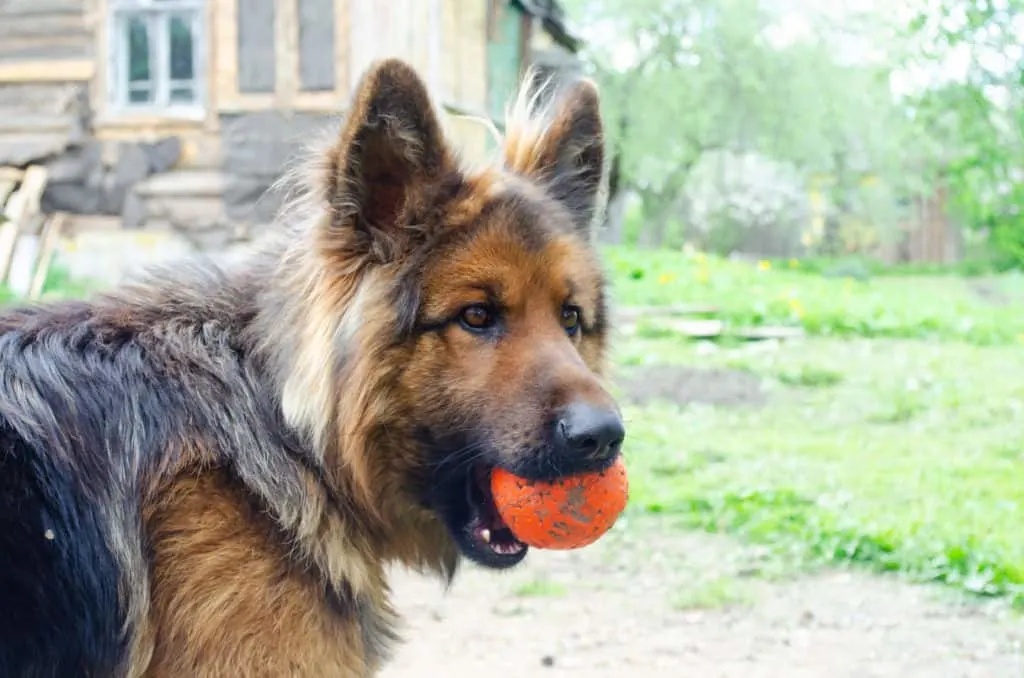
Instead of waiting to deal with your GSD’s anxiety when a storm has already come about, be proactive about it and give your dog some exercise before a storm.
Consider taking your dog for a long walk prior to the arrival of a storm, and include intensive playtime as well. Before a thunderstorm is an ideal time to have a full-on session of fetch with your German Shepherd.
If you are someone who works out at a gym, think about how you feel after a hard workout. If you are not someone who works out, then think of how you feel after a long walk. You are tired, but in the best way. Your endorphin levels have been raised, and you are calm and you feel accomplished.
The same holds true of your German Shepherd after intense activity. If you rigorously exercise your dog before a storm hits, then his anxiety will be considerably lessened. With any luck, he may sleep through the entire thunderstorm!
Consider Using a ThunderShirt for Your Dog
A “ThunderShirt” is a product that is designed to interact with a stressed animal and produce effects similar to those of swaddling a baby.
These shirts were developed based on the observation that certain kinds of touch and pressure can actually work to calm a dog during stressful times. This concept was introduced by Temple Grandin, a professor of animal science at Colorado State University.
Grandin is an animal behavior expert and an autism advocate. She discovered the benefits of using touch-based pressure for people with autism. This finding was simply applied to dogs, and the ThunderShirt was born.
In a study conducted by Grandin and several of her peers, it was found that
Pressure from the ThunderShirt has value in heart rate reduction for dogs with Separation Anxiety or Generalized Anxiety Disorder who experience stressful situations.
King, C., Buffington, L., Smith, T.J., Grandin, T., The effect of a pressure wrap (ThunderShirt®) on heart rate and behavior in canines diagnosed with anxiety disorder, Journal of Veterinary Behavior (2014), doi: 10.1016/j.jveb.2014.06.007.
ThunderShirts have an avid following, and many dog owners swear by the positive results. So if your German Shepherd is exhibiting fear and anxiety during thunderstorms, a ThunderShirt may be a helpful tool to help alleviate this.
Desensitize Your German Shepherd to the Sound of Thunder Through Recordings
Another helpful way to address your dog’s fear of thunderstorms is by playing recordings of thunderstorms.
Occasionally exposing your GSD to the sounds of thunderstorms may help to combat fear and anxiety experienced during real storms. Begin by playing the sounds quietly, and then gradually increase the sound over time.
This technique requires little effort on your part, and the results may vary. As previously discussed, thunderstorms are a lot more than just loud sounds.
There are temperature and pressure changes during a real thunderstorm, as well as lightning and static electricity – not to mention the house shaking!
Here is a video with 4 hours of thunderstorm sounds. Try playing this for your dog when it’s not raining outside, or even in the winter when thunderstorms are completely absent.
It may help to acclimate your GSD to the experience and reduce his anxiety the next time a real thunderstorm comes your way.
Keep in mind that, as mentioned, a real thunderstorm contains many elements that a recording will be unable to replicate.
Because of this, a recording may not be overly effective for curing a dog’s pre-existing anxiety around thunderstorms, but instead, it could be a useful way to introduce a younger dog to the sounds as a means of prevention.
Use Music or Background Noise to Distract Your German Shepherd
Sometimes the addition of some background noise or music can help to distract some of your GSD’s attention away from a thunderstorm.
According to Debra Horwitz, DVM of VCA Animal Hospitals, music like rap or anything else with a lot of constant heavy drum beats can help.
You do not need to turn the volume up extremely loud, just loud enough so that the beat can work as a distraction. This will help your dog from allowing a thunderstorm from commanding all of his attention.
Background noises other than music can also help. A lot of us have a loud box fan that we hesitate to use because we find it to be annoying. But you now have a reason to use it!
Just make sure that you do not point the fan at your dog, as the wind coming from it may actually work to exacerbate your dog’s anxiety.
Also useful are ambient or white noise devices. These devices are relatively inexpensive and many people find them useful for sleeping or even studying. Most of these ambient noise devices also have a built-in “rain” or “thunderstorm” setting, so it may be worth your while to invest in one.
The Aurola Sleep Sound Machine is one which we’ve found to fit the bill rather perfectly. It’s small, easily portable, and it has a full range of 7 different sounds to choose from, including:
- White Noise
- Howling Wind
- Ocean Wave
- Rainforest
- Summer Night
- Lullaby
- Thunderstorm
While it may seem that the “Thunderstorm” setting defeats the purpose of the machine, as we’ve discussed, the sound of a thunderstorm can actually serve to acclimate your GSD to the sounds and over time may help to altogether rid your pup of his fear of thunderstorms.
It also has a built-in timer that has been shown to be very effective in establishing and even correcting good sleep patterns for both you and your dog!
If you have a computer handy, a smart tv, or a streaming device, then try playing this video for your dog. It’s 30 minutes long, and can be a good distraction for your dog as a storm is approaching and also once it gets underway.
If you have Spotify, you can also find a number of curated playlists dedicated to relaxing your dog. Here is an example of such a playlist, but you can uncover many more through a simple search.
Behavioral Counter-Conditioning and Training
A solution to address thunderstorm anxiety in GSDs that I have seen work in the past to reduce or even eliminate it is counter-conditioning.
The premise behind this is simple – you simply train your dog to associate a fun or “working” activity with the onset of a thunderstorm.
One way to do this (it works best with younger dogs who haven’t yet developed a fear of thunderstorms) is to teach your dog to associate play with a thunderstorm.
At the first sign of an approaching storm, grab your dog’s favorite toy take him puppy outside to play.
When this works, it really works. I have seen a dog respond so completely to this that he would run and get his toy as soon as he sensed a storm coming. The only downside was to the dog’s owner, who wasn’t always in the mood to play when her dog was!
Another way to counter-condition your German Shepherd to thunderstorms is to use a “inside” leash.
There is no special “inside” leash per se, it’s just a leash that you will use exclusively for counter-conditioning your dog. This is often called getting your dog to “settle” on command, and it can be accomplished in a few simple steps.
- When the weather is sunny and pleasant outside, put the leash on your dog inside your home.
- Take a seat, and have your dog come and lie down at your side.
- When your dog obeys, reward her with a treat.
- Repeat this until your dog positively responds every time.
- When a thunderstorm is on its way, and at the first sign of anxiety in your dog, put the leash on your dog and have her come and lie down at your side, rewarding her once again.
Training your dog to settle on command will cause her to focus on a working activity instead of focussing on her anxiety. As working dogs, nothing makes a German Shepherd happier than satisfying her owner.
If trained properly, a GSD will put her fears aside and favor performing whatever task that she has been charged with carrying out.
Pheremones
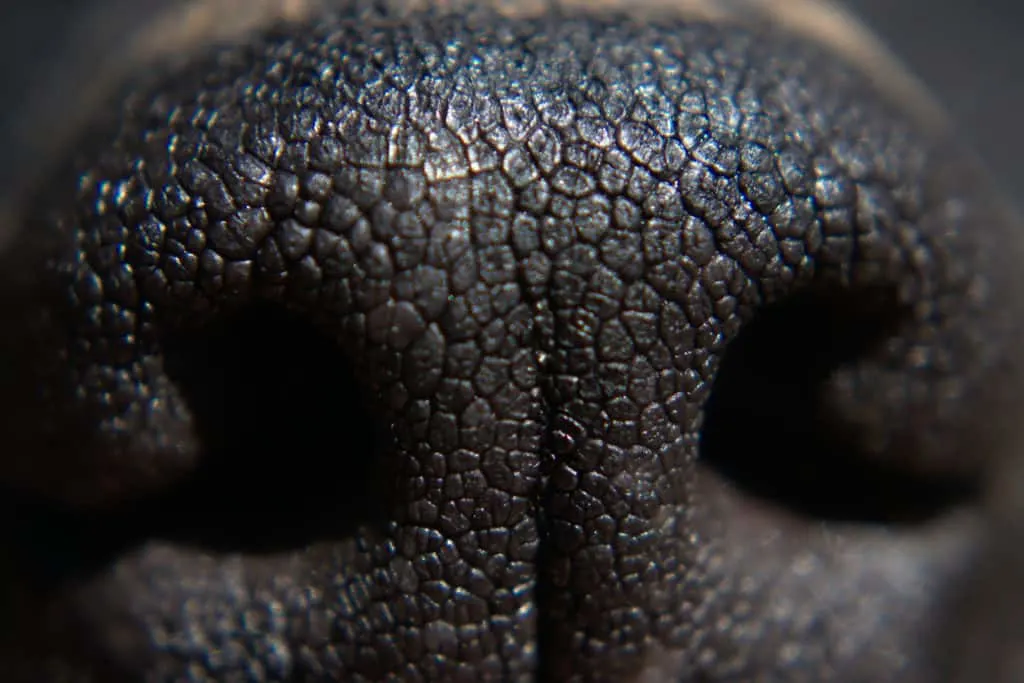
Pheremones can be described as a type of chemical that allows communication between the same species of animal.
When a dog is responding to another dog’s scent, he is actually responding to the chemical pheromones contained within that scent. Based on what a dog detects in a scent, he may become calm, irritated, or aggressive.
This same chemical communication principle applied scientifically has been developed into pheromones that can soothe your German Shepherd if he is experiencing fear and anxiety during a thunderstorm.
A study published in the British Medical Journal has demonstrated that pheromones can be used to effectively reduce a dog’s anxiety during thunderstorms.
The study was conducted over the course of two testing days, and found that fear and anxiety levels were “significantly improved during and following thunder compared with placebo on both test days.”
Additional findings demonstrated that DAP (dog-appeasing pheromone) significantly decreased fear and anxiety for all of the dogs in the study both during and after thunderstorms in comparison to how the dogs reacted before the pheromone was administered to them.
One such product, Adaptil, uses specific pheromones to reduce a dog’s stress and anxiety due to loud noises like thunder.
Adaptil is available in spray and diffuser forms, as well as a collar. Depending on the method of pheromone delivery, the product can last from several hours (spray) up to 30 days (collar).
Just choose the method of delivery most effective for your particular dog. A GSD with mild anxiety may benefit more from a shorter lasting spray or diffuser, while a dog with a more pronounced fear of thunder may benefit most from the longer-lasting collar.
Talk With Your Veterinarian About Medication
I always suggest using medication for your dog’s anxiety only as a last resort, and sometimes that’s just where you are – you have run out of options.
If you’ve tried everything else suggested, then perhaps it is time to reach out to your veterinarian.
Your veterinarian will be able to assess why the measure that you’ve taken haven’t been effective for your individual German Shepherd, and she may come to the conclusion that medication is worth trying.
Dr. Barbara L. Sherman, Ph.D., DVM, states “Not every dog needs anti-anxiety medication, but dogs that are in a horrible state of high anxiety will really benefit.”
The frequency of administering medication will depend on the dog. Some dogs require medication throughout the entire storm season, while others are sufficiently benefitted by being administered medication only on the days that a storm is likely.
In a study on storm phobia in dogs completed by the University of Georgia, the findings showed that 30 of 32 dogs studied benefitted from the use of medications.
The findings of the study stated specifically that:
Panting, pacing, trembling, remaining near the caregiver, hiding, excessive salivation, destructiveness, excessive vocalization, self-trauma, and inappropriate elimination all decreased significantly during treatment. Improvement was greater during true storms (rain, thunder, and lightning) than during rain only.
Department of Anatomy and Radiology College of Veterinary Medicine, University of Georgia, Athens.
The study also concluded that 2 of the dogs were completely cured of storm phobia, and after 4 months, all of the dogs maintained their improvement levels.
Also of note, in 2016 the first FDA approved treatment for noise aversion. “Noise aversion” is described as “the set of anxiety- or fear-based behaviors that dogs can display when subjected to “noise triggers.””
The medication, Sileo, is a gel that is absorbed into a dog’s body after it has been applied to the mucous membranes located between a dog’s cheek and gums.
The active ingredient, Dexmedetomidine, works to calm a dog by suppressing specifically targeted reactions in a dog’s nervous system.
The British Medical Journal published a study relating to the specific effects of Dexmedetomidine gel as to its effectiveness on dogs’ anxiety as it relates to fireworks.
The study found that:
The properties of dexmedetomidine gel in treating dogs suffering from acute anxiety and fear associated with fireworks were measurable, clinically relevant and statistically significant.
Dexmedetomidine significantly reduced behaviours related to fear and anxiety over time, and the overall effect and success of treatment were found superior to placebo.
Furthermore, the dose used was safe and devoid of any significant clinical sedative effect. Finally, the novel administration form and delivery system was found by owners to be easy to use across the range of dogs tested.
Korpivaara, M., Laapas, K., Huhtinen, M., Schöning, B., Overall, K. (2017) Dexmedetomidine oromucosal gel for noise-associated acute anxiety and fear in dogs—a randomised, double-blind, placebo-controlled clinical study Veterinary Record 180, 356.
The bar graph below represents the percentage of dogs that were positively affected by the administration of dexmedetomidine gel compared to a placebo during the above-mentioned study.
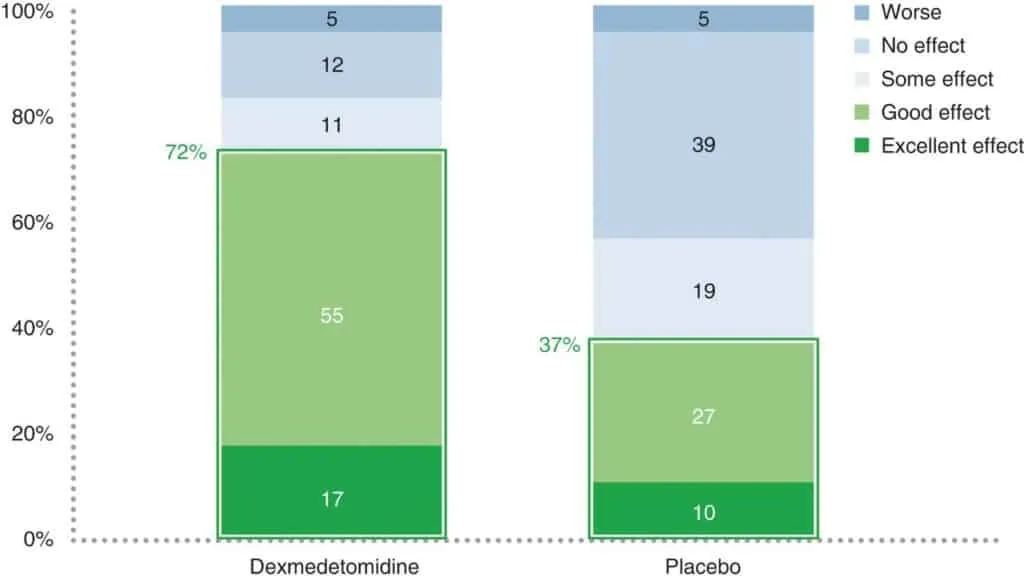
While it is not ideal to give a German Shepherd, or any dog for that matter, medication unless it’s truly necessary, take comfort in knowing that when all other natural remedies fail there is hope in medication.
Try Introducing Calming Treats
If your preference is to stay away from medications, your dog may find comfort in calming treats such as NaturVet Quiet Moments.
These treats hep to promote normal nervous system function by using a specific formulation fo Thiamin, L-Tryptophan, Melatonin, and ginger. Not only are they useful in calming your dog during thunderstorms, but they are also a great product to have on hand while traveling with a nervous pup, and a definite go-to on the 4th of July!
Final Thoughts
It’s never a nice feeling to see your beloved German Shepherd in a fearful state because of a thunderstorm. Your dog’s stress is very real, so you have good reason to feel the way that you do.
Thankfully, there are many solutions to this problem, but they all depend on you being proactive and committing to resolving your dog’s fear.
It may take some patience and a bit of trial and error, but if you stay committed, there is no reason that your German Shepherd will have to live in a fearful state during thunderstorms any longer.




